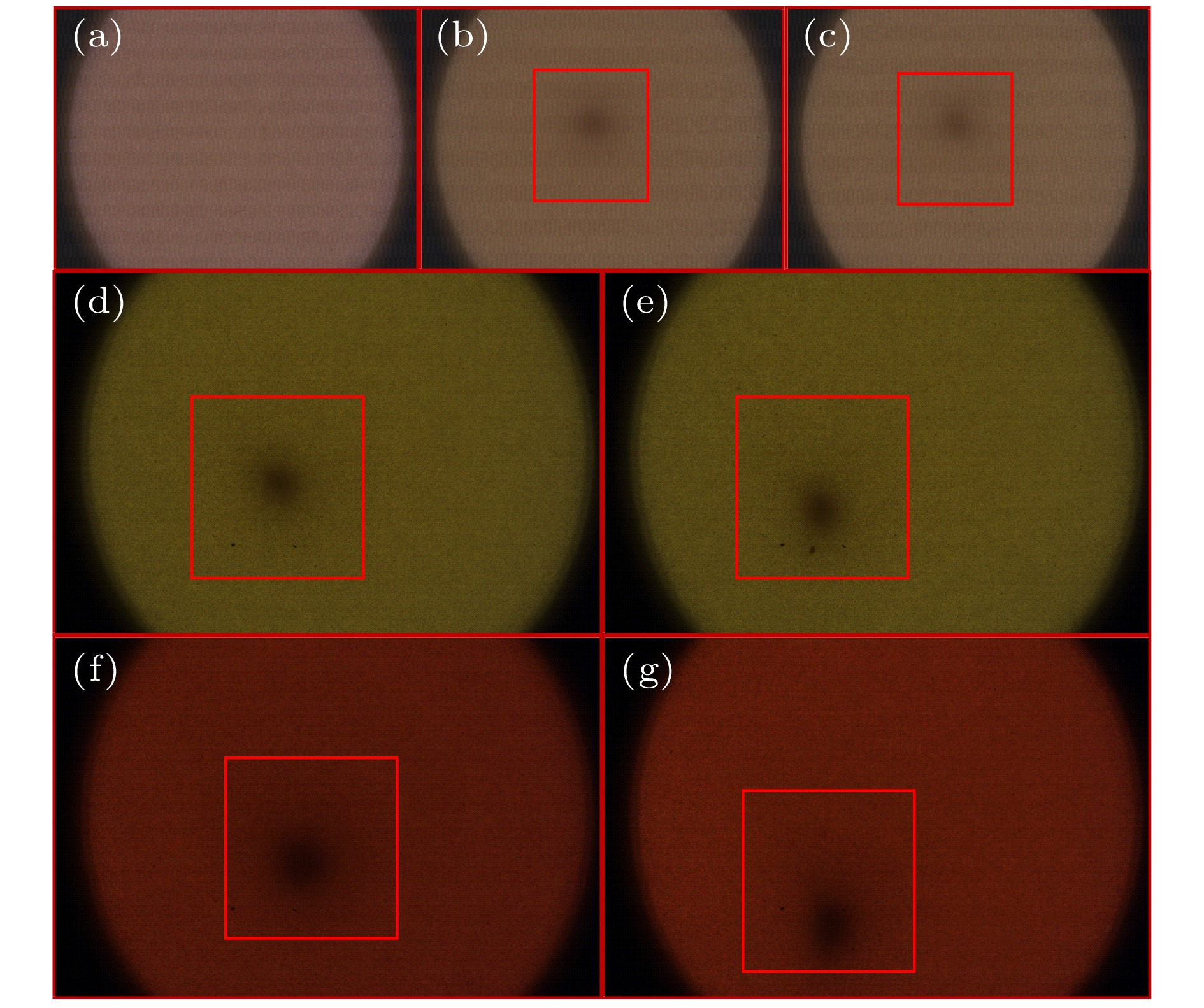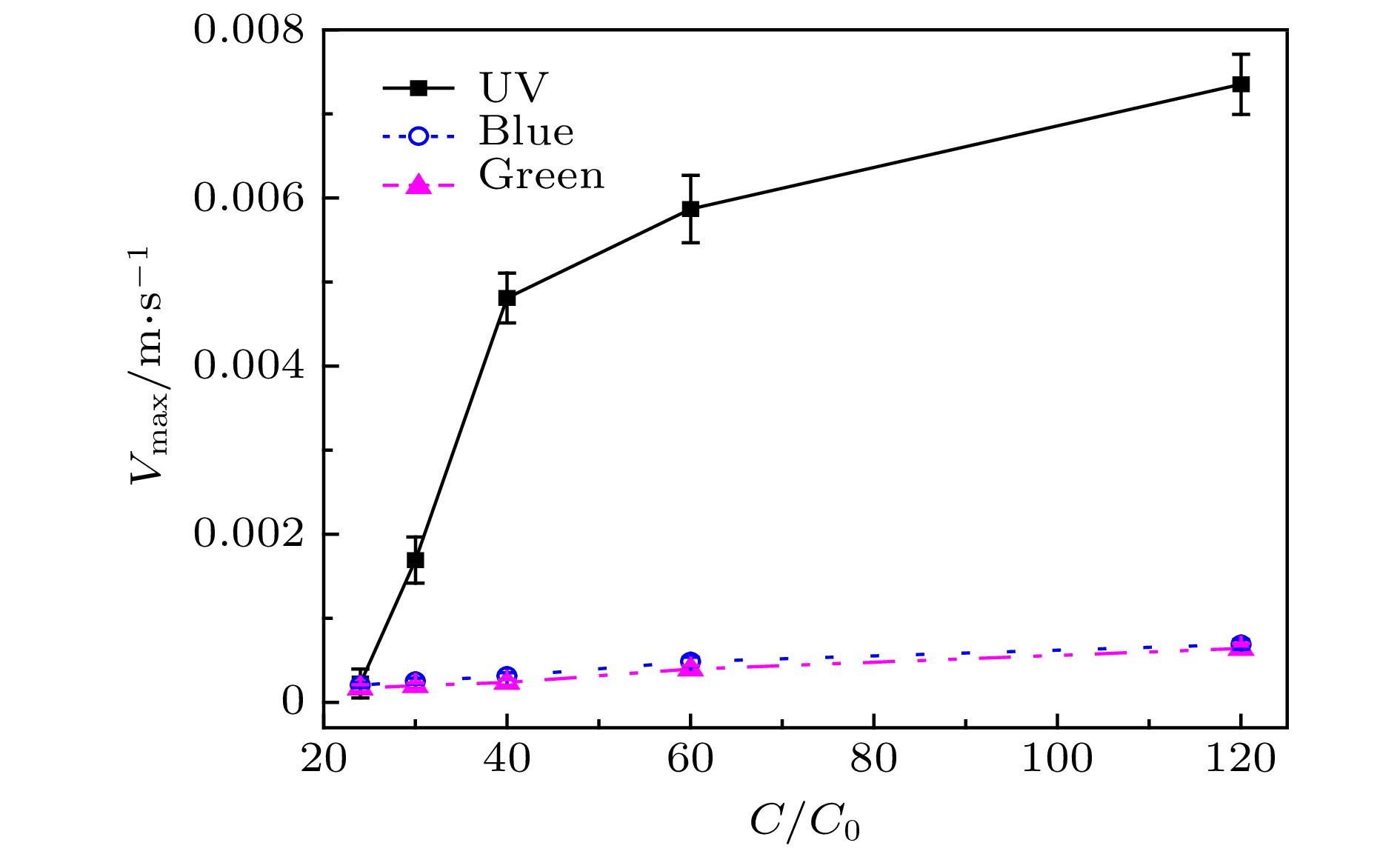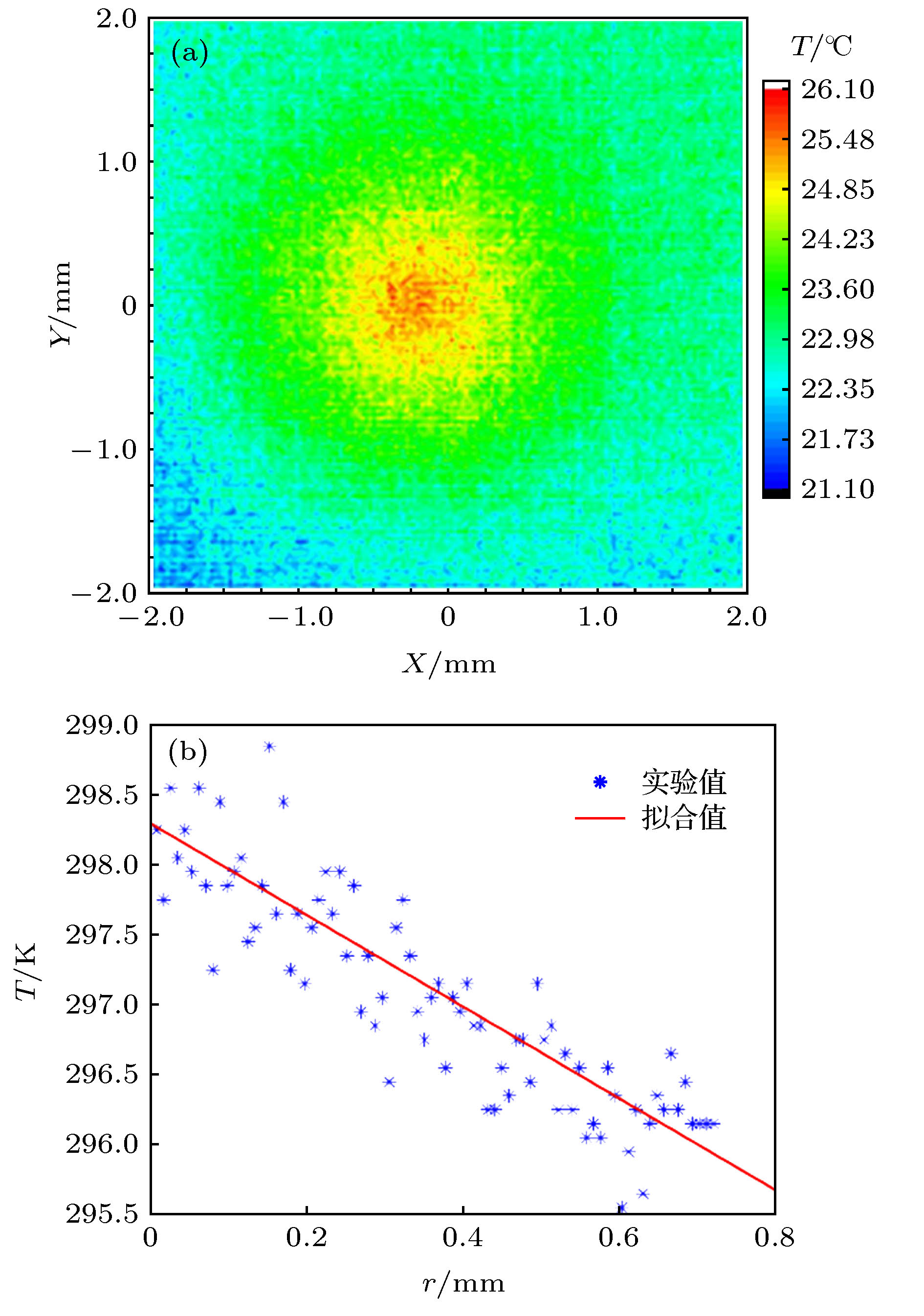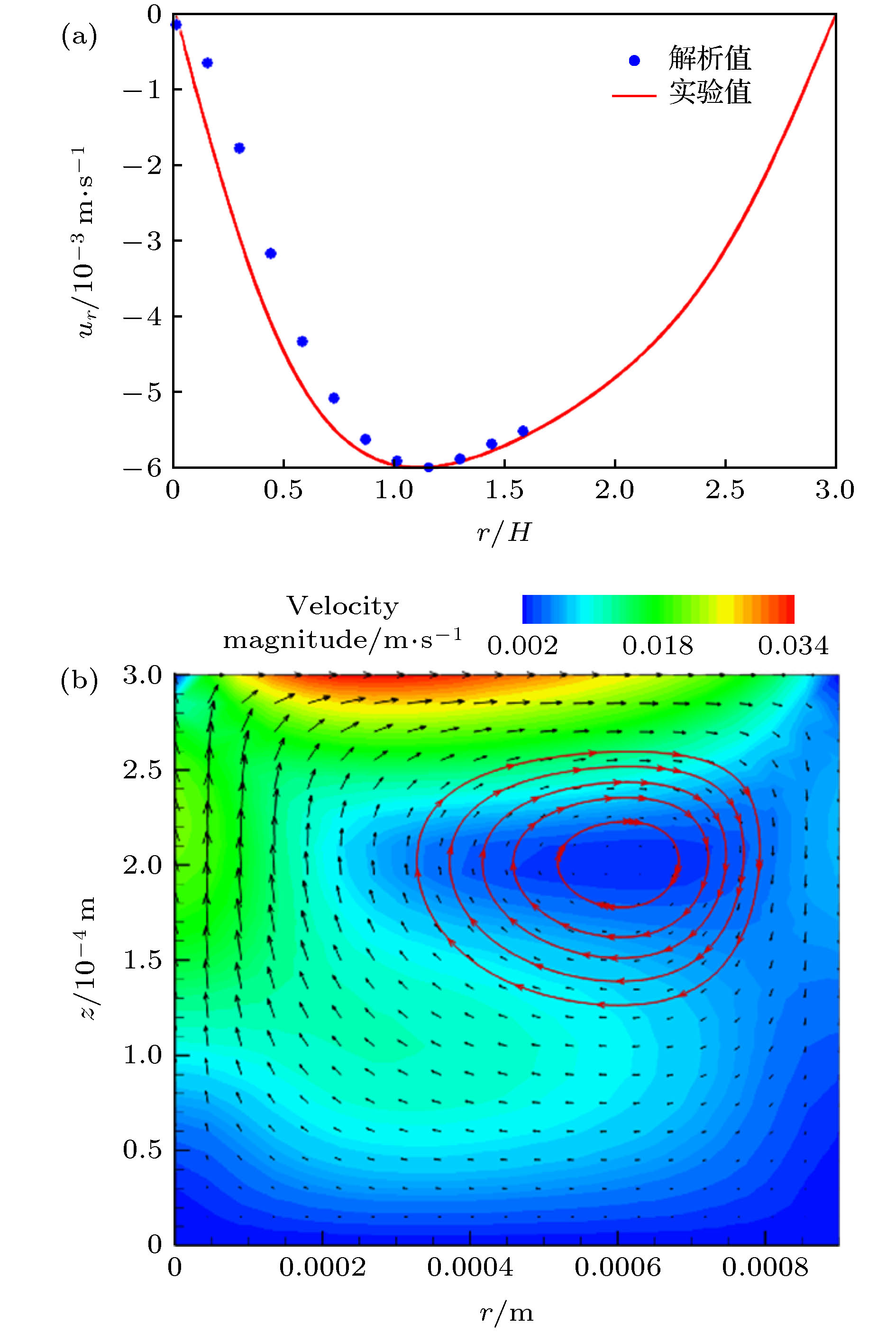-
在光透过性的流体介质中添加具有高光响应特性的纳米颗粒, 可以形成光驱动纳米流体, 实现对光能的高效利用. 本文针对光驱纳米流体流动行为开展实验观察和理论分析研究, 这是实现光驱纳米流动精确调控的理论基础. 首先利用粒子图像测速技术对液滴中直径为300 nm的Fe3O4颗粒在不同光源照射下受Marangoni效应诱导的运动进行了实验观测, 研究光能向动能的高效转化机制. 实验结果表明, 当颗粒浓度大于临界数密度时, 可诱导出垂向具有对称结构的涡, 在液滴底部颗粒由四周向中心运动, 顶部则由中心向四周运动, 光源频率和颗粒数密度是这一过程的主导因素. 随后, 针对光强高斯分布的紫外光驱动下大颗粒数密度、特征流速约mm/s的光驱纳米流体, 通过Stokes方程和表面张力梯度边界条件实现了其流场分布的解析求解, 理论获得的流场分布解析解与实验测量结果保持一致, 证实定量理论分析的有效性. 最后, 讨论了引入表面张力与在液滴底部引入表面压力及体相中集中引入光辐射力的不同驱动模式之间的相关性. 这一研究成果为光微流控系统中流动行为的精确调控及光能的高效转化等提供了理论支持.
-
关键词:
- 纳米流体 /
- 粒子图像测速 /
- Marangoni效应 /
- 表面张力 /
- 光辐射力
Adding nanoparticles with high light response characteristics to a light-transmitting fluid medium can form a light-driven nanofluid and achieve efficient use of light energy. This paper conducts the experimental observation and theoretical analysis of the light driven nanofluid flow behavior, which is the theoretical basis for achieving the precise control of optical drive nanofluid. To realize the efficient conversion of light energy into kinetic energy, here, the motion of Fe3O4 particles with a diameter of 300 nm in droplets induced by the Marangoni effect is studied under different light sources by using the particle image velocimetry (PIV). The experimental results show that when the number density of particles is higher than the critical value, the vertical vortices with symmetrical structure can be induced. At the bottom of the droplet, the particles move from the periphery to the center of droplet, and at the top of the droplet, the particles move from the center to the periphery of droplet. In addition, the frequency of light source and the number density of particles are the dominant factors in this process. Subsequently, for the light driven nanofluid experiment in this paper, the analytical solution of the flow field distribution is achieved by using the Stokes equation and the surface tension gradient boundary condition. The analytical solution of the flow field distribution obtained here is consistent with the experimental results, confirming the validity of the quantitative theory. Finally, the correlation between various driving modes, including surface tension at the top surface, surface pressure at the bottom surface or concentrated light radiation force in bulk phase, is discussed. This research provides theoretical support for the precise regulation of flow behavior and efficient conversion of light energy in the optical microfluidic system.-
Keywords:
- nanofluids /
- particle image velocimetry /
- Marangoni effect /
- surface tension /
- light radiation force
[1] Rivière D, Selva B, Chraibi H, Delabre U, Delville J P 2016 Phys. Rev. E 93 023112
 Google Scholar
Google Scholar
[2] 赵晟, 尹剑波, 赵晓鹏 2010 物理学报 59 3302
 Google Scholar
Google Scholar
Zhao S, Yin J B, Zhao X P 2010 Acta Phys. Sin. 59 3302
 Google Scholar
Google Scholar
[3] Vela E, Hafez M, Régnier S 2009 Int. J. Optomechatronics 3 289
 Google Scholar
Google Scholar
[4] Lee C Y, Chang C L, Wang Y N, Fu L M 2011 Int. J. Mol. Sci. 12 3263
 Google Scholar
Google Scholar
[5] Liu G L, Kim J, Lu Y, Lee L P 2006 Nat. Mater. 5 27
 Google Scholar
Google Scholar
[6] Kajorndejnukul V, Sukhov S, Dogariu A 2015 Sci. Rep. 5 14861
 Google Scholar
Google Scholar
[7] Xuan M, Wu Z, Shao J, Dai L, Si T, He Q 2016 J. Am. Chem. Soc. 138 6492
 Google Scholar
Google Scholar
[8] Dervaux J, Resta M C, Brunet P 2017 Nat. Phys. 13 306
 Google Scholar
Google Scholar
[9] Ibele M, Mallouk T E, Sen A 2009 Angew. Chem. Int. Ed. Engl. 48 3308
 Google Scholar
Google Scholar
[10] Mou F Z, Kong L, Chen C R, Chen Z H, Xu L L, Guan J G 2016 Nanoscale 8 4976
 Google Scholar
Google Scholar
[11] Bricard A, Caussin J B, Desreumaux N, Dauchot O, Bartolo D 2013 Nature 503 95
 Google Scholar
Google Scholar
[12] 李银妹, 姚焜 2015 光镊技术 (北京: 科学出版社) 第23, 24页
Li Y M, Yao K 2015 Optical Tweezers Technology (Beijing: Science press) pp23, 24 (in Chinese)
[13] Thielicke W, Stamhuis E J 2014 J. Open Res. Software 2 e30
 Google Scholar
Google Scholar
[14] 彭晓峰, 林雪萍, 王补宣 1998 工程热物理学报 19 715
Peng X F, Lin X P, Wang B X 1998 J. Eng. Thermophys. 19 715
[15] 严宗毅 2002 低雷诺数流理论 (北京: 北京大学出版社) 第73−77页
Yan Z Y 2002 Low Reynolds Number Flow Theory (Beijing: Peking University Press) pp73−77 (in Chinese)
[16] Kagan D, Laocharoensuk R, Zimmerman M, Clawson C, Balasubramanian S, Kang D, Bishop D, Sattayasamitsathit S, Zhang L, Wang J 2010 Small 6 2741
 Google Scholar
Google Scholar
[17] Gao W, Kagan D, Pak O S, Clawson C, Campuzano S, Chuluun-Erdene C, Shipton E, Fullerton E E, Zhang L F, Lauga E, Joseph W 2012 Small 8 460
 Google Scholar
Google Scholar
[18] Manesh K M, Balasubramanian S, Wang J 2010 Chem. Commun. 46 5704
 Google Scholar
Google Scholar
[19] Manesh K M, Campuzano S, Gao W, Lobocastañón M J, Shitanda I, Kiantaj K, Wang J 2013 Nanoscale 5 1310
 Google Scholar
Google Scholar
[20] Chraibi H, Wunenburger R, Lasseux D, Petit J, Delville J P 2011 J. Fluid Mech. 688 195
 Google Scholar
Google Scholar
[21] Morgan H, Green N 2002 AC Electrokinetics: Colloids and Nanoparticles (England: Research Study Press) pp144−147
-
图 3 不同光源驱动下Fe3O4颗粒的空间分布 (a) 明场; (b) UV照射3 s; (c) UV照射6 s; (d) Blue照射3 s; (e) Blue照射6 s; (f) Green照射3 s; (g) Green照射6 s
Fig. 3. The spatial distribution of Fe3O4 particles driven by different light sources: (a) Bright field; (b) UV irradiation, 3 s; (c) UV irradiation, 6 s; (d) blue irradiation, 3 s; (e) blue irradiation, 6 s; (f) green irradiation, 3 s; (g) green irradiation, 6 s.
-
[1] Rivière D, Selva B, Chraibi H, Delabre U, Delville J P 2016 Phys. Rev. E 93 023112
 Google Scholar
Google Scholar
[2] 赵晟, 尹剑波, 赵晓鹏 2010 物理学报 59 3302
 Google Scholar
Google Scholar
Zhao S, Yin J B, Zhao X P 2010 Acta Phys. Sin. 59 3302
 Google Scholar
Google Scholar
[3] Vela E, Hafez M, Régnier S 2009 Int. J. Optomechatronics 3 289
 Google Scholar
Google Scholar
[4] Lee C Y, Chang C L, Wang Y N, Fu L M 2011 Int. J. Mol. Sci. 12 3263
 Google Scholar
Google Scholar
[5] Liu G L, Kim J, Lu Y, Lee L P 2006 Nat. Mater. 5 27
 Google Scholar
Google Scholar
[6] Kajorndejnukul V, Sukhov S, Dogariu A 2015 Sci. Rep. 5 14861
 Google Scholar
Google Scholar
[7] Xuan M, Wu Z, Shao J, Dai L, Si T, He Q 2016 J. Am. Chem. Soc. 138 6492
 Google Scholar
Google Scholar
[8] Dervaux J, Resta M C, Brunet P 2017 Nat. Phys. 13 306
 Google Scholar
Google Scholar
[9] Ibele M, Mallouk T E, Sen A 2009 Angew. Chem. Int. Ed. Engl. 48 3308
 Google Scholar
Google Scholar
[10] Mou F Z, Kong L, Chen C R, Chen Z H, Xu L L, Guan J G 2016 Nanoscale 8 4976
 Google Scholar
Google Scholar
[11] Bricard A, Caussin J B, Desreumaux N, Dauchot O, Bartolo D 2013 Nature 503 95
 Google Scholar
Google Scholar
[12] 李银妹, 姚焜 2015 光镊技术 (北京: 科学出版社) 第23, 24页
Li Y M, Yao K 2015 Optical Tweezers Technology (Beijing: Science press) pp23, 24 (in Chinese)
[13] Thielicke W, Stamhuis E J 2014 J. Open Res. Software 2 e30
 Google Scholar
Google Scholar
[14] 彭晓峰, 林雪萍, 王补宣 1998 工程热物理学报 19 715
Peng X F, Lin X P, Wang B X 1998 J. Eng. Thermophys. 19 715
[15] 严宗毅 2002 低雷诺数流理论 (北京: 北京大学出版社) 第73−77页
Yan Z Y 2002 Low Reynolds Number Flow Theory (Beijing: Peking University Press) pp73−77 (in Chinese)
[16] Kagan D, Laocharoensuk R, Zimmerman M, Clawson C, Balasubramanian S, Kang D, Bishop D, Sattayasamitsathit S, Zhang L, Wang J 2010 Small 6 2741
 Google Scholar
Google Scholar
[17] Gao W, Kagan D, Pak O S, Clawson C, Campuzano S, Chuluun-Erdene C, Shipton E, Fullerton E E, Zhang L F, Lauga E, Joseph W 2012 Small 8 460
 Google Scholar
Google Scholar
[18] Manesh K M, Balasubramanian S, Wang J 2010 Chem. Commun. 46 5704
 Google Scholar
Google Scholar
[19] Manesh K M, Campuzano S, Gao W, Lobocastañón M J, Shitanda I, Kiantaj K, Wang J 2013 Nanoscale 5 1310
 Google Scholar
Google Scholar
[20] Chraibi H, Wunenburger R, Lasseux D, Petit J, Delville J P 2011 J. Fluid Mech. 688 195
 Google Scholar
Google Scholar
[21] Morgan H, Green N 2002 AC Electrokinetics: Colloids and Nanoparticles (England: Research Study Press) pp144−147
计量
- 文章访问数: 13476
- PDF下载量: 135
- 被引次数: 0













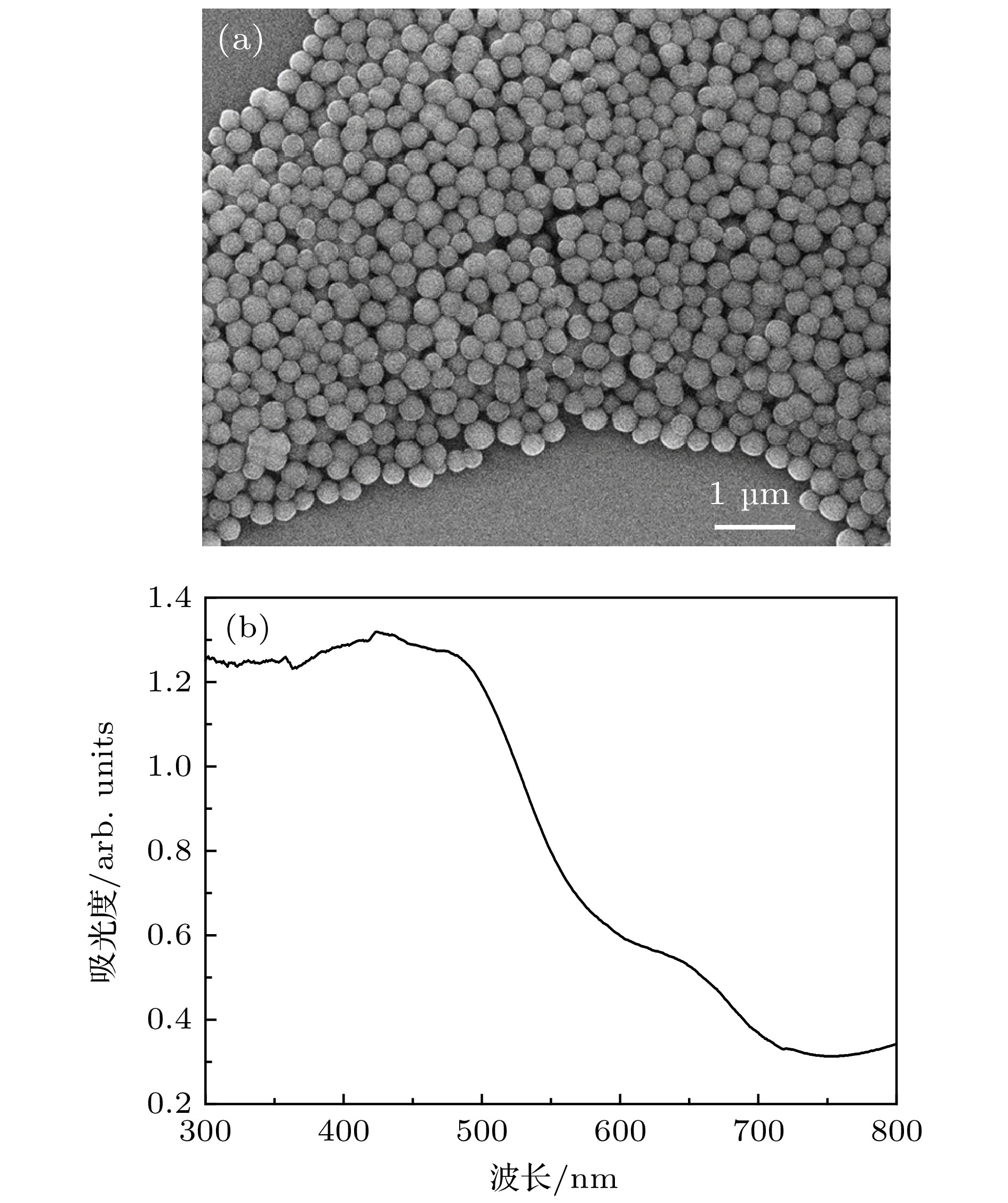
 下载:
下载:

